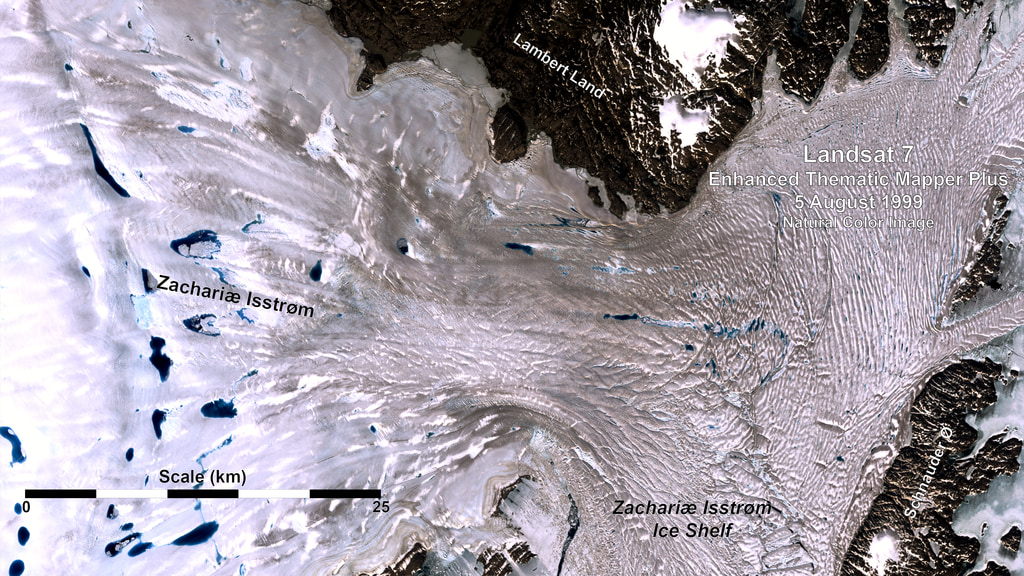A newer version of this visualization is available.
Changes in Zachariae Isstrom Glacier
Zachariae Isstrom glacier, close up
Zachariæ Isstrøm has become the latest Greenland glacier to undergo rapid changes in a warming world. Research
published November 2015 in Science found that Zachariæ Isstrøm broke loose from a stable position in 2012 and entered a phase of accelerated retreat.
The consequences will be felt for decades to come. The reason? Zachariæ Isstrøm is big. It drains ice from a 91,780 square kilometer (35,440 square mile) area of northeast Greenland. That’s about 5 percent of the Greenland Ice Sheet. The glacier holds enough water to raise global sea level by more than 46 centimeters (18 inches) if it were to melt completely. It is already shedding billions of tons of ice into the far North Atlantic each year.
“North Greenland glaciers are changing rapidly,” said lead author Jeremie Mouginot of the University of California, Irvine (UCI). “The shape and dynamics of Zachariæ Isstrøm have changed dramatically over the last few years. The glacier is now breaking up and calving high volumes of icebergs into the ocean, which will result in rising sea levels for decades to come.”
As of 2015, the glacier is losing 5 billion tons of ice every year. The time-lapse animation above shows the glacier’s retreat during the 2015 melt season. The animation is composed of 26 natural-color images acquired by Landsat 8 from May 19 through October 1, 2015.
To better understand the changes taking place at Zachariæ Isstrøm, Mouginot and his colleagues from NASA’s Jet Propulsion Laboratory (JPL), and the University of Kansas compiled an array of airborne and satellite data. The scientists determined that the bottom of Zachariæ Isstrøm is being rapidly eroded at the coast by warmer ocean water that mixes with growing amounts of meltwater from the ice sheet.
“Zachariæ Isstrøm is being hit from above and below,” said the study’s co-author Eric Rignot, who has a joint appointment at UCI and JPL. “The top of the glacier is melting away as a result of decades of steadily increasing air temperatures, while its underside is compromised by currents carrying warmer ocean water, and the glacier is now breaking away into bits and pieces and retreating into deeper ground.”
For more about this research, read JPL’s full feature story.
Zachariae Isstrom glacier, expanded view

Zachariae Isstrom glacier, full-frame images used in both animations
Credits
Please give credit for this item to:
NASA's Goddard Space Flight Center
-
Animator
- Amy Moran (Global Science and Technology, Inc.)
-
Visualizer
- Jesse Allen (SSAI)
-
Writers
- Kathryn Hansen (SSAI)
- Alan Buis (NASA/JPL CalTech)
- Brian Bell (UCI)
Missions
This page is related to the following missions:Series
This page can be found in the following series:Release date
This page was originally published on Friday, February 12, 2016.
This page was last updated on Monday, February 3, 2025 at 12:45 AM EST.
